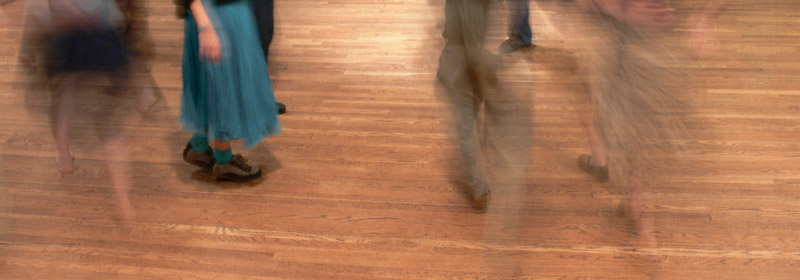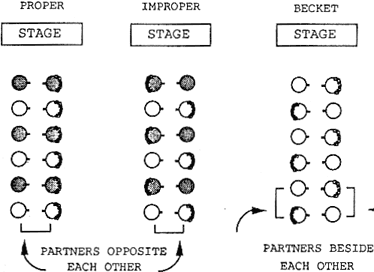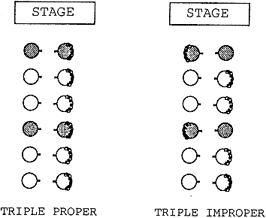Appendix A
CONTRA DANCE FORMATIONS
Types of Contra Dance Formations
Contra dance formations can be divided into duple formations, in which every second couple moves down the set (away from the music) while alternating couples move up the set (toward the music), and triple formations, in which every third couple moves down the set and the remaining couples move up the set. The couples moving down the set are called the active couples and the couples moving up the set are called the inactive couples, because in the traditional dances the couples moving down the set have the more active role in the dance figures.
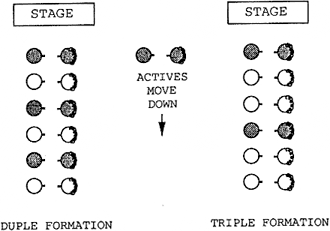
Figure 21. The Duple and Triple Formations
In the duple formation the figures are performed within subgroups of four dancers, and in the triple formation the figures are performed within subgroups of six dancers. These subgroups are called minor sets. After the dancers line up the caller will ask them to take "hands four" or "hands six" starting from the top of each set to determine these subgroups.
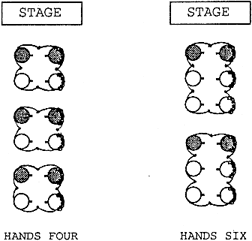
Figure 22. Minor Sets in Duple and Triple Formations
There are three linear duple formations. A duple proper contra dance is one in which the men are in one line and the women are in the other line standing across from their partners. A duple improper contra dance is one in which the active couples change places with their partners, resulting in alternating genders in each line. A Becket formation contra dance is one in which partners stand next to each other on one side or the other of the contra dance set. This formation is named after the dance, "Becket Reel," an early composed dance by Herbie Gaudreau, which was, to the best of my knowledge, the first contra dance to use this formation. There are no active or inactive couples in Becket formation; each couple progresses one place around the outside of the set with every repetition of the dance:
Triple formation contra dances, like the duple ones, may be either proper or improper, depending on whether the men (or women) are all on one side of the set or whether the active couples change places with their partners instead:
Two other formations sometimes used for the contra dance are the Sicilian circle formation and the double contra formation. The Sicilian circle is a contra line that has been curved around the room into a circle so that the ends of the set meet. Instead of moving down the set and back up, each couple moves either clockwise or counterclockwise around the circle as long as the dance continues, never needing to turn around:
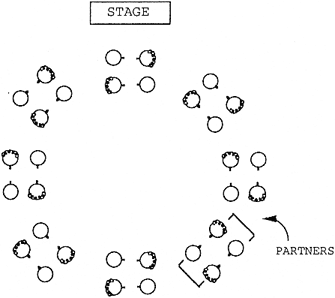
Figure 25. Sicilian Circle Formation
The double contra formation, also called "Portland Fancy" formation after the dance of that name, is simply two contra lines put together at the sides, resulting in groups of four dancers moving up and down the set instead of two. The subgroup dancing the figures becomes a group of eight dancers:
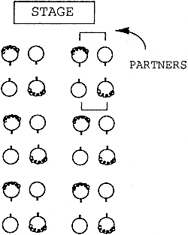
Figure 26. Double Contra Formation
The Progression
It is the progression that gives the contra dance its distinctive character. Because each couple progresses to a new position for each round of the dance, they meet and dance with every other couple in the set in turn. In the duple proper and improper formations the odd numbered couples, or active couples, move one position down the set (away from the music) and the even numbered couples, or inactive couples, move one position up the set (toward the music) for each repetition of the dance. At either end of the set, a couple must wait out one time through the dance before re-entering the set moving in the other direction. During the wait couples will commonly rest, talk, or dance with one another:
In a Becket formation dance the progression goes down the set on one side and up the other, either clockwise or counter-clockwise around the set. Sometimes couples do not need to wait out at the ends in this formation; other times a couple at the end of one side of the set must wait out all or part of a particular figure if no other dancers are in the position to do it with them:

Figure 28. Waiting Out in Becket Formation
The progression in a triple formation contra dance, either proper or improper, occurs as every third couple moves one place down the set, while the other two couples in each minor set move up. The inactive couples alternate being couple two and couple three as they move up the set. At the top of the set a couple must wait out two times through the dance to acquire two more couples with whom to begin the dance again. At the bottom of the set two couples must dance with a ghost third couple in order to progress (see "End Effects" below).
Multiple progression dances are contra dances in which the dancers progress more than one place during a single repetition of the dance. Theoretically they may be in any of the above formations, but they are usually in the duple proper or improper formations. Double progressions are the most common kind of multiple progression dance, in which the active couples progress two places down the set during each repetition of the dance. Triple and quadruple progressions are possible, but rare. The multiple progression dances move the dancers through the various positions faster, but leave less time for social interaction with other couples along the way. Dancers must be ready to re-enter the dance more quickly at the ends of the sets.
End Effects
When a contra dance is done in a line, rather than in a circle, the dancers must change roles at each end and re-enter the dance going the other way. This change of direction may result in end effects, things the dancers must do or be aware of as they change roles.
In a duple contra dance there are two invariable end effects. One is that a couple must wait out one time through the dance at each end of the set before re-entering, as described above. The second is that in an improper formation dance the man and the woman dancing together must switch places before re-entering the dance, since in the improper formation men and women alternate along the sides of the set. Other end effects occur in particular situations. If a dance is a double progression dance, it is usually the case that a couple at the end need only wait out for half the length of the dance and must cross over quickly if the dance is improper, because they are most commonly pulled back into the dance after only sixteen measures of music instead of the usual thirty-two. If a dance contains figures that go out of the minor set (the subgroup of four dancers) and involve dancers in neighboring subgroups, then this will affect the couple waiting out at the end, who may be temporarily needed for an "allemande," a "swing," or some other dance move.
In Becket formation, the last couple on one or the other side of the set may need to modify some figures of the dance. For example, if couples are to slide left, the end couples must slide around the end of the set. If a diagonal figure is called for, such as a "right and left through" diagonally to the left, then one couple at the end will have no other couple with whom to dance. In this case they must wait out that particular move, and continue with the dance as soon as they are able (see Figure 28).
In triple formation dances, the end effects are different at the two ends, as described above. At the top of the set a couple must wait out two times through the dance in order to gather two more couples with whom to dance. At the bottom of the set an active couple must dance with the one remaining inactive couple plus a ghost third couple in order to assure a progression, and must then wait out one time alone at the end before re-entering as an inactive couple. Because the triple formation is less used in modern choreography, there are few, if any, instances in the triple formation of either multiple progression or figures that use dancers outside the minor set.
